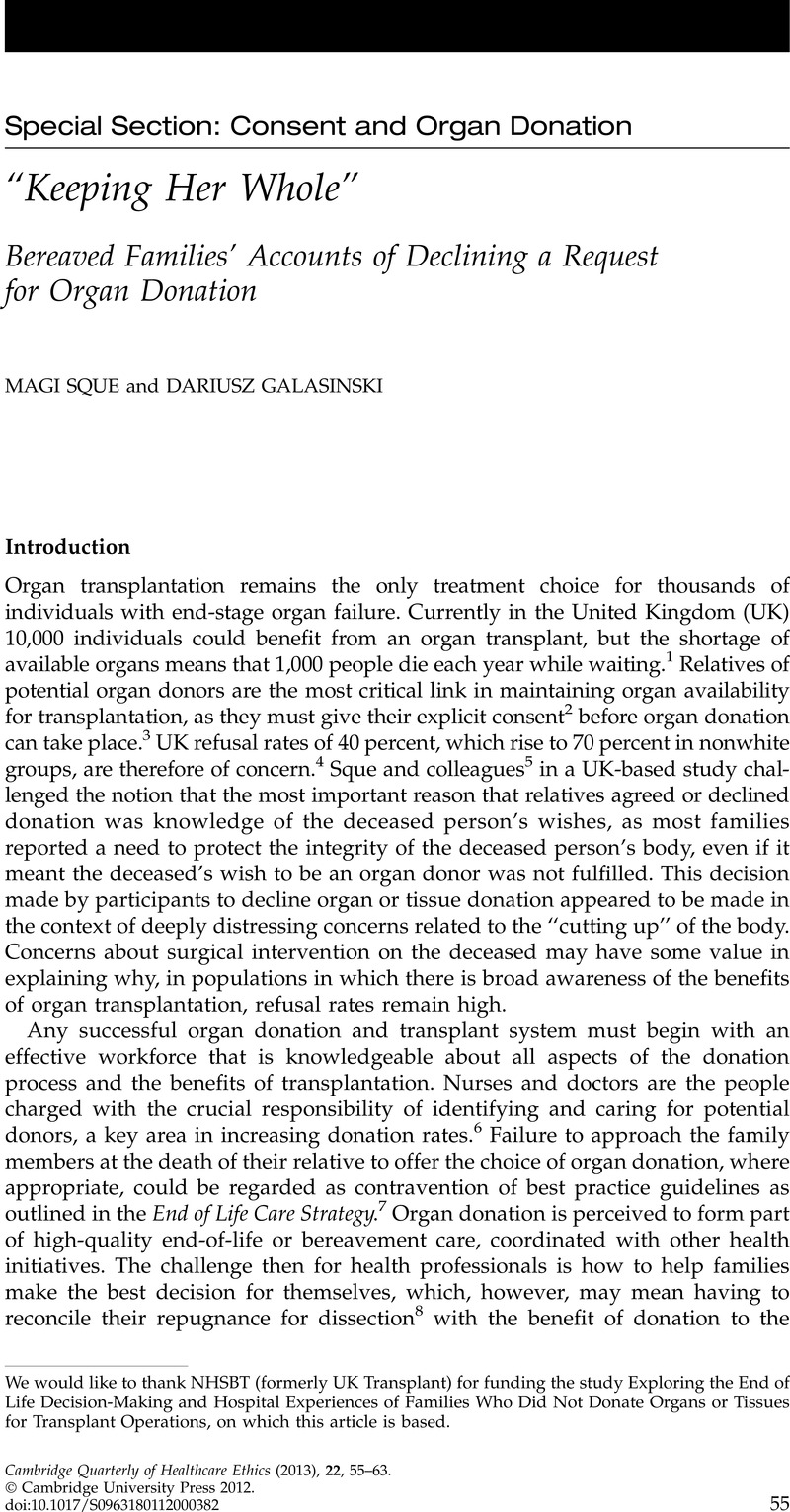Bereaved Families’ Accounts of Declining a Request for Organ Donation
Published online by Cambridge University Press: 04 December 2012

1. NHSBT; available at http://www.uktransplant.org.uk/ukt/default.jsp (last accessed 11 Jan 2011).
2. The Human Tissue Act, which got royal assent in November 2004 and was implemented in April 2006 (for transplantation September 2006), states in part 1, section 2, that in the case of a child “appropriate consent means the consent of a person who has parental responsibility for him (the child).” Section 3 states that in the case of an adult “appropriate consent” rests with “a nominated person” or “person who stood in a qualifying relationship to him immediately before he died.” There are a number of criteria listed defining qualifying relationships.
3. Human Tissue Act, London: Her Majesty’s Stationery Office; 2004.
4. Department of Health (DH). Organs for Transplants: A Report from the Organ Donation Taskforce. London: DH; 2008.Google Scholar
5. Sque, M, Long, T, Payne, S, Allardyce, D. Why relatives do not donate organs for transplants: "Sacrifice" or "gift of life"? Journal of Advanced Nursing 2008;61:134–44.Google Scholar
6. See note 4, DH 2008.
7. Department of Health (DH). End of Life Care Strategy: Promoting High Quality Care for All Adults at the End of Life. London: DH; 2008.Google Scholar
8. Richardson, R. Human dissection and organ transplantation in historical context. In: Sque, M, Payne, S, eds. Organ and Tissue Donation: An Evidence Base for Practice. Maidenhead: Open University Press; 2007:4–20.Google Scholar
9. Glaser, B. The use of secondary analysis by the independent researcher. American Behavioural Scientist 1963;6:93–102.Google Scholar
10. Heaton, J. Reworking Qualitative Data. London: Sage; 2004.Google Scholar
11. Long-Sutehall, T, Sque, M, Addington-Hall, J. Secondary analysis of qualitative data: A valuable method for exploring sensitive issues with an elusive population? Journal of Research in Nursing 2010:1–10.Google Scholar
12. See note 5, Sque et al. 2008, at 134–44.
13. Hodge, R, Kress, G. Language as Ideology. London: Routledge; 1993.Google Scholar
14. van Leeuwen, T, Wodak, R. Legitimizing immigration control. Discourse Studies 1999:1:83–118.Google Scholar
15. Fairclough, N. Discourse and Social Change. Oxford: Polity Press; 1992.Google Scholar
16. Halliday, MAK. An Introduction to Functional Grammar. 2nd ed.London: Edward Arnold; 1994.Google Scholar
17. Van Dijk, TA. Principles of critical discourse analysis. Discourse & Society 1993;4:249–83.Google Scholar
18. Barker, C, Galasiński, D. Cultural Studies and Discourse Analysis. London: Sage; 2001.Google Scholar
19. See note 15, Fairclough 1992.
20. See note 16, Halliday 1994.
21. See note 16, Halliday 1994.
22. See note 16, Halliday 1994.
23. For more accessible reading, we decided to simplify the transcription to the absolute minimum, leaving only the basic intonation signatures (full stops) as well as noting significant pauses (dots in round brackets) and backchannel responses. Omitted text is noted in square brackets. Italicized text indicates the fragments to which we want to draw the readers’ attention.
24. Halliday, MAK. Language as Social Semiotic. London: Edward Arnold; 1978.Google Scholar
25. Halliday, MAK, Hasan, R. Language, Context, and Text. Oxford: Oxford University Press; 1985.Google Scholar
26. Galasiński, D. Men and the Language of Emotions. Basingstoke: Palgrave; 2004.Google Scholar
27. Epistemic modality is the capacity of clauses to express the speaker’s certainty, from very low to very high (see note 16, Halliday 1994). Modalization introduces an aspect of degree and thus makes propositions weaker or stronger.